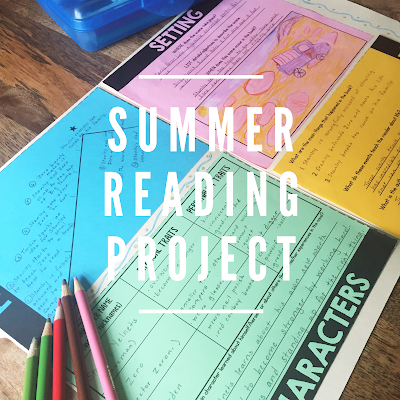Raise your hand if you signed up to teach summer school. That was me for many, many summers of my teaching career. Just as the school year was drawing to a close, I found myself preparing for a new batch of students that would be progressing through curriculum at an accelerated pace.
Let's face it, summer school is a very unique experience. In my case my class periods were much longer, my students were brand new to me, the program was regional so I was in an entirely new building, and in a lot of ways it was the very last place most of the students wanted to be That's why I made it my goal each year to not only help my students succeed, but to actually enjoy our days together...and here's how we not only survived, but thrived!
Let's face it, summer school is a very unique experience. In my case my class periods were much longer, my students were brand new to me, the program was regional so I was in an entirely new building, and in a lot of ways it was the very last place most of the students wanted to be That's why I made it my goal each year to not only help my students succeed, but to actually enjoy our days together...and here's how we not only survived, but thrived!
Make the classroom (even if it's a borrowed one) a welcoming place.
Since most of the classrooms I taught in during summer school were not my own, I tried to get creative in making the space feel welcoming for students. I found that it didn't take much to transform the classroom. Here are some of the ways I decorated the room:
--- Hang a clothesline. At the start of summer school I hung motivational posters like these. Then, throughout the summer I used the clothesline to display students' work.
--- Buy a welcome mat. Yes, a welcome mat and tape it down outside of your door. It makes an instant positive impression.
--- Bring in a fun chair. Create a cozy reading corner or design a classroom management reward system around a great chair. The plastic Adirondack chairs are a great inexpensive option.
--- Design a bulletin board with pictures of your summer school students. Use one of the bulletin boards in the classroom as a place to display pictures of your students working all summer long. Just snap a few pics of them each day and print them out. Then, stick them up on the board. It instantly builds community and helps students feel like this is their classroom, too.
Implement a positive classroom management system.
We all know that without a well-managed classroom, teaching and learning are virtually impossible. During summer school I like to establish an easy classroom management system that holds students accountable for their behavior and is simple to implement.
Behavior cards are perfect for this. Just create two sets of cards (or find them for FREE HERE).
One set of cards acknowledges good behavior and the other set redirects misbehavior. The "Keep it Up" cards recognize students doing the right thing. The "Stop" cards encourage students to stop inappropriate behavior. They're simple and effective. Learn more HERE.
We all know that without a well-managed classroom, teaching and learning are virtually impossible. During summer school I like to establish an easy classroom management system that holds students accountable for their behavior and is simple to implement.
Behavior cards are perfect for this. Just create two sets of cards (or find them for FREE HERE).
One set of cards acknowledges good behavior and the other set redirects misbehavior. The "Keep it Up" cards recognize students doing the right thing. The "Stop" cards encourage students to stop inappropriate behavior. They're simple and effective. Learn more HERE.
Design lessons and activities that make learning interesting.
Keeping students' attention during the school year is challenging enough. Add the distractions of beautiful summer days outside of the classroom window and it's even harder. That's why I tried to keep my students on their toes by adding lots of variety to the ways they learned. Here are some of the ways I tried to make the summer days and learning unique:
--- Plan fun activities for the first day of summer school.
--- Send kids on learning scavenger hunts.
--- Work together with another class of students attending summer school.
--- Go outside.
--- Plan engaging learning centers/stations.
--- Invite in guest speakers.
--- Incorporate technology into lessons.
--- Bring in sweet treats for a little fun like popsicles.
--- Play lots of educational games.
--- Plan cooperative learning activities.
Keeping students' attention during the school year is challenging enough. Add the distractions of beautiful summer days outside of the classroom window and it's even harder. That's why I tried to keep my students on their toes by adding lots of variety to the ways they learned. Here are some of the ways I tried to make the summer days and learning unique:
--- Plan fun activities for the first day of summer school.
--- Send kids on learning scavenger hunts.
--- Work together with another class of students attending summer school.
--- Go outside.
--- Plan engaging learning centers/stations.
--- Invite in guest speakers.
--- Incorporate technology into lessons.
--- Bring in sweet treats for a little fun like popsicles.
--- Play lots of educational games.
--- Plan cooperative learning activities.
Teach lessons that pack an instructional punch.
Summer school is all about trying to teach a ton of content in a short amount of time. I've found that the best way to cover a lot of instructional ground is with units that meet a bunch of learning standards at once. My absolute favorite is this 6-week journey-themed unit that meets 38+ learning standards!
With the summer school curriculum, students investigate journeys in the form of a short story, speeches, poetry, historic journal entries, and a personal reflection. Each unit combines rigor and engagement as students read, write, listen, and speak about incredible journeys.
Summer school is all about trying to teach a ton of content in a short amount of time. I've found that the best way to cover a lot of instructional ground is with units that meet a bunch of learning standards at once. My absolute favorite is this 6-week journey-themed unit that meets 38+ learning standards!
With the summer school curriculum, students investigate journeys in the form of a short story, speeches, poetry, historic journal entries, and a personal reflection. Each unit combines rigor and engagement as students read, write, listen, and speak about incredible journeys.
Set a predictable classroom routine.
A structured routine not only helped my students, but it was essential to my survival in summer school. I found that starting and ending the day the same way made planning so much easier. Each day started with daily warm-ups to keep students busy from the second they walked into the classroom.
Then, each class ended with a fun lesson refection or exit ticket.
You know what other routine that I implemented into summer school? Don't laugh, but I brought the idea of snack-time into my summer school classroom. It was a game-changer! Since students were with me for several hours each morning their bodies needed a bit of fuel to get them through the session. I know that it's a very elementary idea, but trust me it was a wonderful daily routine!
If you're teaching summer school, I hope that you and your students have an opportunity to grow and learn together!
Thanks for stopping by!
Mary Beth
P.S. Summer school is the perfect time to get students reading. This summer reading project is 100% turn-key. Just print and go!
A structured routine not only helped my students, but it was essential to my survival in summer school. I found that starting and ending the day the same way made planning so much easier. Each day started with daily warm-ups to keep students busy from the second they walked into the classroom.
Then, each class ended with a fun lesson refection or exit ticket.
You know what other routine that I implemented into summer school? Don't laugh, but I brought the idea of snack-time into my summer school classroom. It was a game-changer! Since students were with me for several hours each morning their bodies needed a bit of fuel to get them through the session. I know that it's a very elementary idea, but trust me it was a wonderful daily routine!
If you're teaching summer school, I hope that you and your students have an opportunity to grow and learn together!
Thanks for stopping by!
Mary Beth
P.S. Summer school is the perfect time to get students reading. This summer reading project is 100% turn-key. Just print and go!















No comments:
Post a Comment